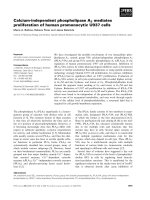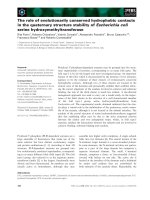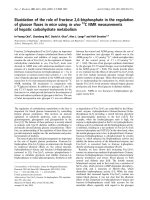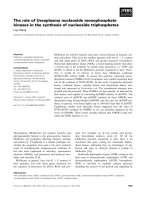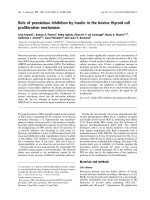Distribution and role of calcium independent phospholipase a2 in the brain
Bạn đang xem bản rút gọn của tài liệu. Xem và tải ngay bản đầy đủ của tài liệu tại đây (6.4 MB, 191 trang )
DISTRIBUTION AND ROLE OF PHOSPHOLIPASE A
2
IN
THE BRAIN
LEE LI YEN
(B.Sc), NUS
A THESIS SUBMITTED FOR THE DEGREE OF
DOCTOR OF PHILOSOPHY
DEPARTMENT OF ANATOMY
NATIONAL UNIVERSITY OF SINGAPORE
2010
Acknowledgements
I
ACKNOWLEDGEMENTS
I wish to express my deepest appreciation and heartfelt thanks to my
supervisor, Associate Professor Ong Wei Yi, Department of Anatomy, National
University of Singapore, for suggesting this study topic and his constant and
patient guidance and encouragement throughout the course of the study. During
my postgraduate study at National University of Singapore, he has not only
introduced me to a new research field but has also been a role model for
hardwork and commitment to research. His deep and sustained interest and
stimulating discussion have been most invaluable in the accomplishment of this
thesis.
I am very grateful to Professor Ling Eng Ang, former Head of
Department of Anatomy, National University of Singapore, for giving me the
opportunity to do my postgraduate study at National University of Singapore. I
am grateful to Professor Bay Boon Huat, Head of Department of Anatomy, for
his full support in using the excellent research facilities. My deep indebtedness
goes to Associate Professor Gavin Stewart Dawe, Department of
Pharmacology, National University of Singapore, who gives me guidance and
comment on my study and kindly offered help in teaching me the use of acoustic
startle reflex apparatus. I am greatly indebted to Associate Professor Go Mei
Lin, Department of Pharmacy, National University of Singapore, for their valuable
suggestions and friendly help during this study.
Acknowledgements
II
I am also acknowledging my gratitude to Mrs Ng Geok Lan and Mrs
Yong Eng Siang for their excellent technical assistance; Miss Chan Yee Gek,
and Mdm Yu Ya Jun for Electron Microscopy work; Mr Yick Tuck Yong for his
constant assistance in computer work; Mdm Ang Lye Gek Carolyne and Mdm
Teo Li Ching Violet for their secretarial assistance.
I would like to thank all other staff members and my fellow postgraduate
students and vital friends in Histology Lab, Neurobiology Programme, Centre for
Life Science, National University of Singapore: Pan Ning, Lim Seok Wei,
Jinatta Jittiwat, Tang Ning, Lee Hui Wen Lynette, Kim Ji Hyun, Ma May Thu,
Poh Kay Wee, and Chia Wan Jie, for their help and support in many ways. It
was a joyful experience working with all of them.
I would like to take this opportunity to express my heartfelt thanks to my
parents and sister for their full and endless support for my study. I am very
grateful to Mr Chow Kum Seng Bernard and Mdm Cheong Hoon Moy Jean for
providing generous financial support. Finally, I am greatly indebted to my
husband, Mr Xu Congyuan for his understanding and encouragement during
this study.
Table of Contents
III
TABLE OF CONTENTS
ACKNOWLEDGEMENTS …………………………………… …… ………………. I
TABLE OF CONTENTS………………………………….……………… ………… III
SUMMARY…………………………………………………….…………… … VIII
LIST OF TABLES………………………………………………………………… XI
LIST OF FIGURES…………………………………………………………… … XII
ABBREVIATIONS…………………………………………………… … ………….XIII
PUBLICATIONS……………………………….…………… ……….…… …….XVI
Chapter I INTRODUCTION 1
1.General introduction 2
1.1. sPLA
2
isoforms 5
1.2. cPLA
2
isoforms 6
1.3. iPLA
2
isoforms 8
2.cPLA
2
in normal brain 11
2.1. Molecular genotype 11
2.2. Localization and distribution of cPLA
2
13
2.3. cPLA
2
functions 13
2.4. Fatty acid released by cPLA
2
14
2.5. cPLA
2
inhibitors 16
3.iPLA
2
in normal brain 17
3.1. Molecular genotype 18
3.2. Localization and distribution of iPLA
2
19
Table of Contents
IV
3.3. iPLA
2
functions 20
3.4. Fatty acid released by iPLA
2
22
3.5. iPLA
2
inhibitors 23
4.cPLA
2
in pathological diseases 25
5.iPLA
2
in pathological diseases 26
6. Roles of PLA
2
in neurodegeneration 27
6.1. Cerebral ischemia 28
6.2. Alzheimer’s disease 28
6.3. Parkinson’s disease 30
7. Roles of iPLA
2
in neuropsychiatric disorders 31
7.1. Schizophrenia 31
7.2. Depression 32
8. Animal models of neuropsychiatric disorders 33
8.1. Acoustic startle reflex 33
8.2. Vacuous chewing movement 36
8.2.1. Dopamine receptors and antipsychotic side effects 38
8.2.2. Dopamine D
2
receptor occupancy 39
8.2.3. Other factors affecting VCM 40
9. Roles of PLA
2
in mitochondrial diseases 41
Chapter II AIM OF STUDY 43
Chapter III EXPERIMENTAL STUDIES 46
Chapter 3.1 Distribution of Calcium-Independent Phospholipase A
2
in the Rat
Brain 47
1. Introduction 48
Table of Contents
V
2. Materials and methods 49
2.1. Animals 49
2.2. Immunocytochemistry 49
2.3. Electro microscopy 51
3. Results 52
3.1. Light microscopy 52
3.1.1. Distribution of iPLA
2
in the normal forebrain of Wistar rat 52
3.1.2. Distribution of iPLA
2
in the basal ganglia and cerebellum of Wistar
rat brain 54
3.2. Electron microscopy 56
4. Discussion 58
Chapter 3.2 Role of Calcium-Independent Phospholipase A
2
in Cortex Striatum
Thalamus Cortex Circuitry-Enzyme Inhibition Causes Vacuous Chewing
Movements in Rats
1. Introduction 62
2. Materials and methods 64
2.1. Chemicals 64
2.2. Antisense oligonucleotides 64
2.3. Rats and treatment 68
2.4. Stereotaxic injections 70
2.5. Behavioral assessment 73
2.6. Western blot analysis 73
3. Results 74
3.1. Rats treated with BEL 74
3.2. Rats treated with MAFP 77
Table of Contents
VI
3.3. Rats treated with iPLA
2
inhibitors plus benztropine 79
3.4. Rats treated with iPLA
2
antisense oligonucleotides 81
4. Discussion 83
Chapter 3.2 Role of Calcium-Independent Phospholipase A
2
in Cortex Striatum
Thalamus Cortex Circuitry-Enzyme Inhibition Causes Vacuous Chewing
Movements in Rats 61
Chapter 3.3 Role of Phospholipase A
2
in Prepulse Inhibition of the Auditory
Startle Reflex in Rats 89
1. Introduction 90
2. Materials and methods 90
2.1. Rats and treatment 90
2.2. Antisense oligonucleotides 91
2.3. Acoustic startle reflex recordings 92
2.4. Statistical analysis 95
3. Results 96
3.1. Acoustic startle response 96
3.2. Prepulse intensity 97
4. Discussion 99
Chapter 3.4 Effects of Calcium-Independent Phospholipase A
2
on Exocytosis
in Rat PC12 Cells 103
1. Introduction 104
2. Materials and methods 105
2.1. Cell culture 105
2.2. Patch clamp and capacitance measurements 105
2.3. PC12 cell treatment 107
Table of Contents
VII
2.4. Mitochondrial membrane potential assay 108
3. Results 109
3.1. Effects of BEL and factors affecting BEL-induced exocytosis on
capacitance measurements in PC12 cells 110
3.2. Effects of BEL on mitochondrial membrane potential 111
4. Discussion 112
Chapter IV CONCLUSION 116
Chapter V REFERENCE 121
Summary
VIII
SUMMARY
One class of phospholipase A
2
(PLA
2
) that does not require calcium for its
activity is the cytosolic calcium-independent PLA
2
(iPLA
2
). In brain tissues, the
basal expression and activity of iPLA
2
is higher than either cytosolic calcium-
dependent PLA
2
(cPLA
2
) or secretory calcium-dependent PLA
2
(sPLA
2
) (Molloy
et al. 1998; Farooqui et al. 1999), and its protein expression decreases during
aging (Aid and Bosetti, 2007). iPLA
2
is not only responsible for regulation of
membrane phospholipid homeostasis (“housekeeping”) in cells (Balsinde et al.
1995), but also plays important roles in intracellular signal transduction.
The present study aims to elucidate the role and distribution of iPLA
2
in
the brain. iPLA
2
immunoreactivity was observed in structures derived from the
telencephalon, whereas structures derived from the diencephalon were lightly
labeled. The midbrain, vestibular, trigeminal and inferior olivary nuclei, and the
cerebellar cortex were densely labeled. Immunoreactivity was observed on the
nuclear envelope of neurons, dendrites and axon terminals using electron
microscopy. Drug-induced tremulous oral movements have been linked to human
Parkinsonian tremor (Salamore et al. 1998). Inhibitors of iPLA
2
could induce
vacuous chewing movements (VCM) in rats. Striatal injections of iPLA
2
inhibitor,
bromoenol lactone (BEL), resulted in significantly increased VCM in Wistar rats
from 2 to 5 days after injection. Significantly increased VCM was also observed
after intrathalamic or intracortical injections of BEL. In contrast, no significant
effect was observed after BEL injection into the cerebellum. The effects of BEL
Summary
IX
were replicable using another PLA
2
inhibitor, methyl arachidonyl
fluorophosphonate (MAFP). These findings suggest that increased VCM after
MAFP injection was because of inhibition of iPLA
2
. The observations with BEL
and MAFP point to a role for inhibition of PLA
2
enzymatic activity in VCM.
Prepulse inhibition (PPI) of the acoustic startle reflex has been widely
used as a model of sensory information processing and sensorimotor gating
(Graham, 1975; Kumari and Sharma, 2002). Our results demonstrate that
systemic administration of the non-specific PLA
2
inhibitor, quinacrine, resulted in
significantly decreased PPI of the auditory startle reflex at 76, 80, and 84 decibel
(dB), compared to saline injected controls. Rats that received intrastriatal
injection of antisense oligonucleotide to iPLA
2
also showed significant reduction
in PPI at prepulse intensities of 76 and 84 dB compared to scrambled sense
injected controls. iPLA
2
inhibition apparently has the same effect as increased
dopamine receptor stimulation, in terms of its effects on PPI. These findings
appear consistent with the previous findings that iPLA
2
inhibition causes VCM.
We have shown that mitochondrial permeability transition pore (MPTP) is
essential in meditating the effect of BEL on exocytosis in PC12 cells. Blocking of
MPTP with the inhibitors bongkrekic acid (BKA) and cyclosporine A (CsA)
resulted in reduced exocytosis after intracellular addition of BEL. p-
trifluromethoxy carbonyl cyanide phenyl hydrazone (FCCP) which depolarizes
mitochondria transition potential and deplete mitochondrial calcium did not have
any effects on exocytosis after addition of BEL. The above results are consistent
Summary
X
with previous studies that overexpression of iPLA
2
has a protective effect on the
mitochondria. It is possible that inhibition of iPLA
2
causes damage to the
mitochondria and release of calcium resulting in exocytosis. The results highlight
the importance of normal “housekeeping” phospholipase A
2
in maintaining the
normal function of neurons.
List of Tables
XI
LIST OF TABLES
Table 1 Treatment group of Wistar rats…………………………………………… 72
Table 2 Two treatment protocols of Wistar rats…………………………………….92
Table 3 Summary of four different types of trials………………………………… 96
Table 4 Acoustic startle in baseline and treatment groups……………………… 97
List of Figures
XII
LIST OF FIGURES
Figure 3.1 Distribution of iPLA
2
in the normal forebrain of Wistar rat……………53
Figure 3.2 Distribution of iPLA
2
in the basal ganglia and cerebellum of Wistar rat
brain…………………………………………………………………………………… 55
Figure 3.3 Electron microscopy………………………………………………………57
Figure 3.4 Degradation of mRNA by RNase H…………………………………… 65
Figure 3.5 Structure of phosphorothioate oligonucleotide……………………… 66
Figure 3.6 Effects of intracerebral BEL injections on VCM……………………… 76
Figure 3.7 Effects of intrastriatal MAFP injection on VCM……………………… 78
Figure 3.8 Effects of benztropine on BEL and MAFP induced VCM…………… 80
Figure 3.9 Effects of antisense and sense injection of oligonucleotides to the
striatum………………………………………………………………………………….82
Figure 3.10 Prepulse inhibition (PPI) experimental setup in rats…………………94
Figure 3.11 Prepulse inhibition of the auditory startle at four prepulse intensities
after quinacrine administration (5 mg/ml, i.p.) compared to saline
controls………………………………………………………………………………….98
Figure 3.12 Prepulse inhibition of the auditory startle response in rats treated with
iPLA
2
antisense oligonucleotide injections and sense controls………………… 99
Figure 3.13 Effects of BEL and factors affecting BEL-induced exocytosis on
capacitance measurements in PC12 cells……………………………………… 111
Figure 3.14 Effects of BEL on mitochondrial membrane potential…………… 112
Abbreviations
XIII
ABBREVIATIONS
AA, arachidonic acid
AACOCF
3
, arachidonyl trifluoromethyl ketone
ABC, avidin-biotin complex
AD, Alzheimer’s disease
AMPA, alpha-amino-3-hydroxy-5-methyl-4-isoxazolepropionate
ASR, acoustic startle reflex
ATP, adenosine triphosphate
BEL, bromoenol lactone
BKA, bongkrekic acid
CA1, hippocampal CA1 area
CA3, hippocampal CA3 area
CCT, CTP:phosphocholine cytidylyltransferase
CerPCho, sphingomyelin
CNS, central nervous system
COX, cyclooxygenase
cPLA
2
, calcium-dependent phospholipase A
2
CsA, cyclosporine A
DAB, 3,3,diaminobenzidine tetrahydrochloride
dB, decibel
DG, dentate granule
DHA, docosahexaenoic acid
DNA, deoxyribonucleic acid
Abbreviations
XIV
EBSS, Earl’s Balanced Salt Solution
EPS, extrapyramidal symptoms
EPSCs, excitatory postsynaptic currents
FCCP, p-trifluromethoxy carbonyl cyanide phenyl hydrazone
FFA, free fatty acid
FKGK11, 1,1,1,2,2-pentafluoro-7-phenyl-heptan-3-one
IL-1β, interleukin 1 beta
IL-6, interleukin 6
iPLA
2
, calcium-independent phospholipase A
2
MAFP, methyl arachidonyl fluorophosphonate
MAO, monoamine oxidase
MPT, mitochondrial permeability transition
MPTP, 1-methyl-4-phenyl-1,2,3,6-tetrohydropyridine
NMDA, N-methyl-D-aspartate
NPD1, neuroprotectin D1
OsO4, osmium tetroxide
PAF, platelet-activating factor
PAP-1, phosphatidate phosphohydrolase
PBN, N-tert-butyl-alpha-phenylnitrone
PBS, phosphate-buffered saline
PC12, pheochromocytoma-12
PD, Parkinson’s disease
PG, prostaglandin
Abbreviations
XV
PLA
2
, phospholipase A
2
PLC, phospholipase C
PLD, phospholipase D
Pls, plasmalogens
PPI, prepulse inhibition
PtdCho, phosphatidylcholine
PtdEtn, phosphatidylethanolamine
PtdIns, phosphatidylinositol
PtdSer, phosphatidylserine
PUFA, polyunsaturated fatty acid
PVDF, polyvinylidine difluoride
R-BEL, R-isomer of BEL
RCM, renal cortex mitochondria
ROS, reactive oxygen species
sPLA
2
, secretory phospholipase A
2
TBS, tris-buffered saline
TD, Tardive dyskinesia
TNF-α, Tumor necrosis factor-alpha
UCH-L1, ubiquitin C-terminal hydrolases L1
VCM, vacuous chewing movement
Publications
XVI
PUBLICATIONS
Various portions of the present thesis have been published:
International Refereed Journals
Lee LY, Ong WY, Farooqui AA, Burgunder JM. (2007) Role of calcium-
independent phospholipase A
2
in cortex striatum thalamus cortex circuitry-
enzyme inhibition causes vacuous chewing movements in rats.
Psychopharmacology 195:387-395
Lee LY, Farooqui AA, Dawe GS, Burgunder JM, Ong WY. (2009) Role of
phospholipase A
2
in prepulse inhibition of the auditory startle reflex in rats.
Neurosci Lett 453:6-8
Chapter I Introduction
1
Chapter I INTRODUCTION
Chapter I Introduction
2
1. General introduction
A phospholipid molecule consists of a diglyceride, a phosphate group,
which may itself be bound to one of a variety of polar head groups such as
choline. A diglyceride is a glyceride consisting of two fatty acyl chains, which are
hydrophobic in nature, covalently bonded to a glycerol molecule through ester
linkages. One exception to this is sphingomyelin, which is derived from
sphingosine instead of glycerol, and contains only one fatty acid linked to an
amino group. With their hydrophilic polar phosphate groups and long
hydrophobic hydrocarbon “tails”, phospholipids readily form membrane-like
structures in water. They are a major component of all cell membranes.
All four ester moieties in a phospholipid are susceptible to enzymatic
hydrolysis. Phospholipases are a family of enzymes that catalyze the hydrolysis
of phospholipids. They are classified into four groups based on their catalytic
activity, namely phospholipase A
1
, A
2
, B, C and phospholipase D. Phospholipase
A
1
cleaves the carboxy ester linkages between the glycerol backbone of the
phospholipid and the acyl chains attached at sn-1 position. Phospholipase A
2
hydrolyzes the acyl ester bond at the sn-2 position of glycerol in membrane
phospholipids to produce free fatty acids and lysophospholipids. Phospholipase
B cleaves both sn-1 and sn-2 acyl chains, they are also known as
lysophospholipase. Phospholipase C cleaves the ester linkage between sn-2
position of the glycerol backbone and the inorganic phosphate moiety of the polar
Chapter I Introduction
3
head group, whereas phospholipase D cleaves the bond between inorganic
phosphate and the polar head group (Boyer, 1983).
Phospholipase A
2
(PLA
2
) represents a large superfamily of enzymes that
catalyze the hydrolysis of the fatty acid or alkyl bond of phospholipids at the sn-2
position, liberating free fatty acids and lysophospholipids. Phospholipids are the
major lipid constituents of neural membranes, and their metabolism is therefore
important to maintain the integrity of the cell membrane. There are many types of
PLA
2
expressed in mammalian tissues. The human genome contains over 25
genes encoding PLA
2
s that have been broadly classified into types based on
their substrate preference, cofactor requirements, and dependence on calcium
for activity, size, and their catalytic mechanism (Cedars et al. 2009). They are
broadly defined into five different types based on functional criteria: secretory
Ca
2+
-dependent PLA
2
(sPLA
2
), cytosolic Ca
2+
-dependent PLA
2
(cPLA
2
), Ca
2+
-
independent PLA
2
(iPLA
2
), platelet-activating factor hydrolases (PAF-AH) and
lysosomal PLA
2
(Cummings et al. 2000; Balsinde et al. 2002; Schaloske and
Dennis, 2006). PLA
2
enzymes also function in the digestion of dietary lipid and
microbial degradation. Their most widely-known function is the regulation of
phospholipid acyl turnover as a housekeeping role for membrane repair or
production of proinflammatory mediators. They provide neural membranes with
stability, fluidity, and permeability. Neural membrane phospholipids are a
reservoir for bioactive lipid metabolites and second messengers. These enzymes
have been purified from many different sources such as mammalian pancreas,
lung, platelets, synovial fluid, insect and snake venoms (Ackermann and Dennis,
Chapter I Introduction
4
1995). They are not only involved in neural cell proliferation, differentiation, and
apoptosis, but also in the modulation of activities of transporters, ion channels,
and membrane-bound enzymes (Farooqui et al. 2000a). It is well known that
phospholipids-mediated signaling involves the generation of bioactive lipid
metabolites in response to agonist-receptor interactions at the plasma membrane
level (Farooqui et al. 2000a).
These bioactive lipid metabolites modulate certain genes in the nucleus.
The occurrence of phospholipids in nuclei has been documented by biochemical
and ultracytochemical procedures (Fraschini et al. 1995; Albi et al. 1996). The
total phospholipids content of nuclei is reported as 3% by weight compared with
75% for protein and 22% for DNA. Major nuclear phospholipids include PtdIns,
PtdCho, and CerPCho. This is in contrast to the plasma membrane that contains
a considerable amount of PtdCho, PtdEtn, PtdSer, and PtdIns (Hunt et al. 2001;
Irvine et al. 2003). The phospholipids contents (per mg protein) of the nuclear
membrane are approximately nine times that of whole nuclei. Collective evidence
suggests that the nucleus is the main site involved in active and autonomous
phospholipids metabolism, with nuclear phospholipids having a composition and
turnover rate different from phospholipids present in plasma membranes,
microsomes, and mitochondria (Fraschini et al. 1999; Tamiya-Koizumi et al.
2002; Martelli et al. 2004; Ledeen et al. 2004).
The nuclear fraction contains many enzymes responsible for the
metabolism of phospholipids, and at the same time, generates and regulates the
Chapter I Introduction
5
levels of second messengers. These enzymes include PLA
2
, phospholipase C
(PLC), phospholipase D (PLD), diacylglycerol lipase (DAG-lipase),
phosphatidylinositol 4-kinase, Mg
2+
-dependent sphingomyelinase, and
CTP:phosphocholine cytidylyltransferase (CCT). The second messengers
generated by these enzymes modulate neural cell proliferation, differentiation,
and apoptosis. During these processes the quantitative ratios among various
phospholipids undergo significant changes depending upon the functional state
of neurons, astrocytes, and oligodendrocytes. It is interesting to note that some
extracellular stimuli, such as retinoic acid, produce bioactive lipid metabolites
only in the nucleus and not in the plasma membrane. The enzymic properties of
phospholipid metabolizing enzymes in the nuclear fraction are different from
those found in plasma membrane, microsomes, and cytoplasm (Maraldi et al.
1999).
1.1. sPLA
2
isoforms
The first type of PLA
2
enzymes discovered were the secreted PLA
2
(sPLA
2
) found in snake venoms, mammalian pancreas, and synovial fluid. They
are characterized by a low molecular weight (13 – 15 kDa), a catalytic site which
contains histidine, Ca
2+
bound in the active site, and six-conserved disulfide
bonds with one or two variable disulfide bonds (Burke and Dennis, 2009).
Millimolar concentrations of Ca
2+
are needed for maximal enzymatic activity
(Boyer, 1983; Wong and Dennis, 1990). It has been implicated as an important
agent involved in both local and systemic inflammatory conditions (reviewed in
Chapter I Introduction
6
Vadas et al. 1993). sPLA
2
gene expression has also been shown to be induced
by various inflammatory stimuli, such as endotoxin, IL-1β, TNF-α, and IL-6
(Vadas et al. 1993). The mechanism of governing the proinflammatory activity of
sPLA
2
is not known. sPLA
2
uses histidine to catalyze phospholipids at the sn-2
position, releasing non-esterified fatty acids and produce lysophospholipids
(Balsinde et al. 2002). However, sPLA
2
has little preference for the type of fatty
acid in the sn-2 position.
Ten members of the sPLA
2
family have been identified in mammals, which
are numbered and grouped in the order of their discovery: group IB (GIB), IIA,
IIC, IID, IIE, IIF, III, V, X and XII (Schaloske and Dennis, 2006). Based on the
position of disulfide bonds and sequence alignment, the mammalian sPLA
2
can
be subdivided into three structural classes (Murakami et al. 2002). Natural gene
mutations of sPLA
2
have been found in a number of inbred mouse strains
(Kennedy et al. 1995). The sPLA
2
gene was disrupted by a frameshift mutation in
exon 3. This mutation terminates out of frame in exon 4, resulting in a disruption
of the calcium binding domain and loss of both activity domains encoded by
exons 4 and 5. The identification of this mutation has important implications in
mouse inflammatory models, which serve to define the physiological role of
sPLA
2
and ascertain its contribution in the inflammatory process.
1.2. cPLA
2
isoforms
The cPLA
2
family consists of six intracellular enzymes, cPLA
2
α, cPLA
2
β,
cPLA
2
γ, cPLA
2
δ, cPLA
2
ε and cPLA
2
ζ. They are intracellular PLA
2
of a high
Chapter I Introduction
7
molecular weight (85 – 110 kDa), and play “housekeeping” roles by facilitating
phospholipid remodeling and maintaining phosphatidylcholines (Balsinde et al.
1996, 1997; Ramanadham et al. 1999; Ma et al. 2001). Much research has
focused on cPLA
2
α because of its central and functional role through its ability to
trigger release of arachidonic acid and eicosanoids (Leslie et al. 1997). cPLA
2
β is
found mainly in the cerebellum and shares more similarities with cPLA
2
α than
with cPLA
2
γ (Farooqui and Horrocks, 2007). It has been reported that cPLA
2
γ is
predominantly expressed in the brain, heart, and skeletal muscle in humans
(Pickard et al. 1999; Underwood et al. 1998) and this enzyme is activated in vivo
by serum (Stewart et al. 2002). cPLA
2
δ was identified from psoriatic skin (Chiba
et al. 2004). cPLA
2
δ, together with cPLA
2
ε and cPLA
2
ζ, were cloned and
characterized from novel murine cPLA
2
, which forms a gene cluster with cPLA
2
β
(Ohto et al. 2005). The role of these paralogs of cPLA
2
in brain tissues remains
speculative.
The PLA
2
activity of cPLA
2
α is characterized by Ca
2+
-dependence for its
activity and substrate preference for arachidonoyl phospholipids (Leslie 1997;
Sharp et al. 1991; Clark et al. 1991; Hirabayashi et al. 2004). Submicromolar
concentrations of calcium binding is required for translocation of the enzyme from
the cytosol to the endoplasmic reticulum, Golgi apparatus and perinuclear
membranes, and it is subsequently activated by phosphorylation via the MAPK
pathway (Balsinde et al. 1999; Murakami et al. 1998, 2000). With the exception
of cPLA
2
γ, all known cPLA
2
s require micromolar concentrations of calcium for
membrane association via a C2 domain (Perisic et al. 1998; Clark et al. 1991).
Chapter I Introduction
8
cPLA
2
has a 20-fold preference for arachidonic acid over other unsaturated fatty
acids in phospholipid substrates (Clark et al. 1991).
1.3. iPLA
2
isoforms
Generally, iPLA
2
is a 85 – 88 kDa protein that exists as a multimeric
complex of 270 – 350 kDa with a specific activity (Tang et al. 1997). They utilize
a serine to catalyze the hydrolysis of the sn-2 ester bond (Balsinde et al. 2002). A
majority of what we know about the function of iPLA
2
comes from studies in
macrophages. iPLA
2
from P338D1 macrophages does not show a preference for
either sn-2 arachidonic acid or sn-1 alkyl-ether containing phospholipids
(Ackermann et al. 1994). Other iPLA
2
s acting on plasmalogen substrate have
been isolated and characterized from the brain (for review see Farooqui et al.
1995). Plasmalogen-selective PLA
2
from pig brain tissues has a molecular mass
of 39 kDa and is markedly inhibited by glycosaminoglycans. Heparan sulfate is
most potent inhibitor, followed by hyaluronic acid, chondroitin sulfate, and
heparin (Yang et al. 1994a). N-acetylneuraminic acid, gangliosides, and
sialoglycoproteins also inhibit the plasmalogen-selective PLA
2
in a dose-
dependent manner (Yang et al. 1994b).
At present, seven distinct isoforms of iPLA
2
have been identified at the
genetic level and they are designated as iPLA
2
α (Andrews et al. 1988), iPLA
2
β
(Tang et al. 1997), iPLA
2
γ (Mancuso et al. 2000), iPLA
2
δ (neuropathy target
esterase) (van Tienhoven et al. 2002), iPLA
2
ε (adiponutrin), iPLA
2
ζ (TTS-2.2),
and iPLA
2
η (GS2) (Jenkins et al. 2004). Four of the iPLA
2
isoforms (iPLA
2
α,

